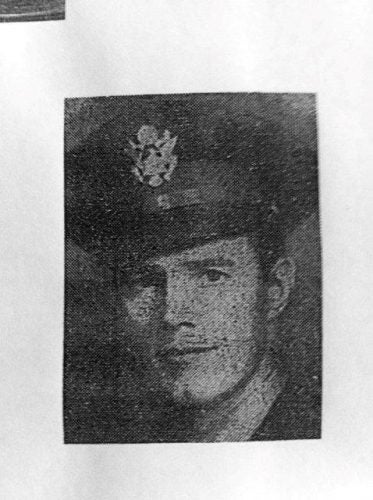- Captain
- WW II
Biography
Charles Frederick Pratte, Jr. was born in Fall River, Massachusetts on 29 March 1915 and grew up in Warren, Rhode Island. He was the son of Charles Frederick Pratte, Sr. and Audella C. Pratte. Charles attended local schools in Warren. He entered Rhode Island State College (RISC) in September 1937 with the class of 1941 and participated in the Army ROTC program for one year. Charles left RISC after his freshman year and worked in the restaurant/steamship industry until he enlisted in the U.S. Army Air Forces on 8 April 1941.
Private Charles F. Pratte, Jr. graduated from the ten-week U.S. Army Air Forces preflight training program, a combination of enlisted basic training and officer candidate school. He was assigned as a cadet at the Flying/Aviation Cadet Training Program, U.S. Army Air Forces Training Center, Duncan Field, Alabama. Upon completion of flight school, he was awarded his pilot’s wings, commissioned a Second Lieutenant and assigned to the 42nd Bomb Squad, 11th Bombardment Group, Hickam Field, Hawaii.
The 11th Bombardment Group participated in the Battle of Midway. Shortly after Midway, the 11th Group was assigned as a mobile force under Admiral Nimitz. As a mobile group, the 11th Group left Hawaii to support Navy operations in the South Pacific during the Guadalcanal and North Solomon Campaigns. The 11th Group deployed to Ellice Island in November 1943 and participated in the Allied offensive through the Gilbert, Marshall and Marianas Islands.
In December 1943, Captain Charles Pratte was the pilot of the B-24 Liberator, “Belle of Texas,” returning from a bombing mission when he was attacked by Japanese planes. The Japanese planes did major damage and destroyed the brakes of the “Belle of Texas” which had to make an emergency landing. Captain Pratte instructed the crew to tie three parachutes to the gun mounts. This provided sufficient drag to halt the plane in landing. The plane landed safely, and Captain Pratte became nationally famous for his ingenuity when the classification of this incident was lifted.
For his actions, Captain Pratte was cited for Gallantry in Action and Bravery and awarded the Distinguished Flying Cross.
Distinguished Flying Cross Citation
“The President of the United States of America, authorized by act Congress on July 2, 1926, takes pleasure in presenting the Distinguished Flying Cross to Captain Charles Frederick Pratt Jr., United States Army Air Forces, for operational missions of the 42nd Bomb Squad, 11th Bombardment Group, 7th Air force, for heroism while participating in an aerial flight in the Southwest Pacific Area while serving as pilot of a B-24 Liberator “Belle of Texas” and in completing twenty-five missions while participating in an aerial flight in the Southwest Pacific Theater under severe hostile contact by Japanese ground and air attacks.”
The Belle of Texas (# 42-73156) was repaired in January – February, 1944 on Tarawa after the parachute landing in December 1943. When it was repaired, Captain Pratte then flew the Belle to the island of Oahu, Hawaii, where it was decided it should be retired due to everything it had gone through and as newer B 24’s were arriving from the mainland Captain Pratte was issued a replacements aircraft.
Sadly, after 28 missions, on 22 January 1945, Captain Pratte and his crew disappeared after taking off from Saipan on a mine-laying mission in the B24J #42-109871 along the Japanese island of Chichi Jima. The crew was declared Killed in Action in 1946 after a search party found personal articles and pieces of letters addressed to the nine crewmembers. Each member of the crew was awarded a Purple Heart and Air Medal (Posthumously).
Captain Pratte was awarded the Distinguished Flying Cross, the Air Medal with 3 (three) Oak Leaf Clusters and the Purple Heart, among other awards.
Captain Charles Frederick Pratte, Jr., U.S. Army Air Forces, was a hero in defeating the Japanese in the South Pacific. He is another son of Rhode Island and America who answered the call to duty and gave his life during World War II. Charles F. Pratte Jr. and his crew are memorialized by the American Battle Monuments Commission in Hawaii, as well as with a military plaque in Warren RI in the family plot by his brother, Herbert A. Pratte. He is a heroic member of the “Greatest Generation.”
Education
1941

